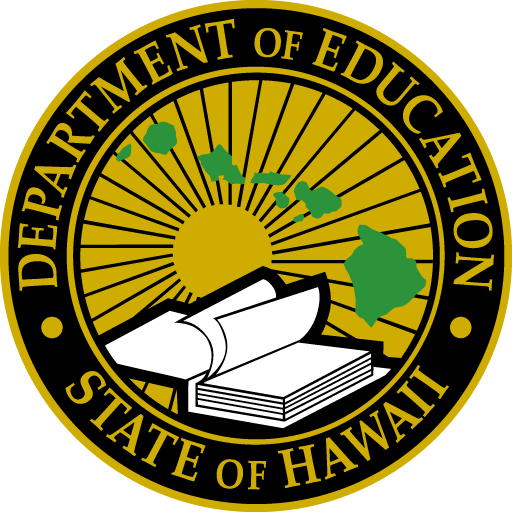Hawaiʻi’s public school แนวทางการดูแลสุขภาพ promote student and staff well-being through policies on health education, nutrition, physical activity and professional development.
wellness in our public schools
แนวปฏิบัติ
“Wellness” in our public schools includes a wellness committee, โภชนาการ แนวทางปฏิบัติ, การศึกษาสุขภาพ การส่งเสริมโภชนาการ การพลศึกษา กิจกรรมทางกาย และการพัฒนาวิชาชีพสำหรับพนักงาน แนวทางการดูแลสุขภาพ ดำเนินการตามคณะกรรมการการศึกษา นโยบาย 103-1 (PDF) และตอบสนองความต้องการของ กฎหมายสาธารณะ 108-265 มาตรา 204 (PDF) และ พระราชบัญญัติเด็กไร้ความหิวโหยเพื่อสุขภาพ (2010).
มีคำแปลในภาษา:
Wellness Committee
All of our schools have a designated wellness coordinator and a committee that meets at least three times per year to address school health issues, including the implementation of the แนวทางการดูแลสุขภาพ. The wellness committee should consist of school administration, faculty and staff, as well as students, families and community representatives. The committee is responsible using data sources (e.g., Youth Risk Behavior Survey) to identify priority areas for the school’s Academic Plan.
At the beginning of each school year, each school community is notified about the wellness policy and provided with the wellness coordinator’s contact information. The schools also encourage students’ families to support wellness at school and at home.
For more information on how you can get involved:
Nutrition แนวปฏิบัติ
Children who eat school lunches are more likely to consume milk, meats, grains and vegetables than students who bring lunch from home. They also tend to have higher nutrient intakes — both at lunch and over the course of an entire day. We make it a priority to ensure students get nutritious meals that fuel learning and physical activities. The Department serves more than 100,000 meals daily during the school year. Learn more about the โภชนาการ แนวทางปฏิบัติ.
Ways schools promote good nutrition:
- ข้อความเชิงบวกเกี่ยวกับอาหารที่มีคุณค่าทางโภชนาการถูกจัดแสดงไว้ในมหาวิทยาลัย
- เครื่องจำหน่ายสินค้าอัตโนมัติสำหรับนักเรียนจะมีแต่เพียงน้ำเท่านั้น
- อาหารกลางวันที่โรงเรียนจะปรุงเองตั้งแต่ต้นให้มากที่สุด รวมไปถึงขนมปังโฮลเกรนอบสดด้วย
- ไม่มีอาหารใดประกอบด้วยไขมันทรานส์
- นักเรียนจะมีน้ำดื่มฟรีไว้บริการในช่วงเวลาอาหาร
- เชิญชั้นเรียนไปเยี่ยมชมห้องครัวโรงอาหารเพื่อเรียนรู้วิธีการเตรียมอาหารเพื่อสุขภาพ
- ส่งเสริมอาหารเช้า อาหารกลางวัน และของว่างที่ดีต่อสุขภาพให้กับนักเรียนและครอบครัวของพวกเขา
- สวนการเรียนรู้จะสาธิตวิธีการเพาะปลูกอาหาร
การส่งเสริมการศึกษาสุขภาพและโภชนาการ
สุขศึกษา and nutrition promotion provide the instructional foundation that is necessary to prepare students to make lifelong healthy decisions and practice healthy behaviors. This component area of the แนวทางการดูแลสุขภาพ รวมถึงการส่งเสริมมื้ออาหารและของว่างที่มีคุณค่าทางโภชนาการทั่วทั้งโรงเรียน รวมไปถึงการศึกษาเรื่องสุขภาพที่มีคุณภาพ
แนวปฏิบัติ for health education and nutrition promotion are organized around ส่วนประกอบหลักสี่ประการ:
- เนื้อหาการเรียนการสอนของชั้นเรียนการศึกษาด้านสุขภาพมุ่งเน้นไปที่ความรู้และทักษะที่สนับสนุนการกินอาหารที่ดีต่อสุขภาพและสอดคล้องกับมาตรฐาน HIDOE สำหรับการศึกษาด้านสุขภาพ
- จัดการศึกษาด้านสุขภาพให้กับนักเรียนในระดับประถมศึกษาอย่างน้อย 45 นาทีต่อสัปดาห์ และระดับมัธยมศึกษาอย่างน้อย 200 นาทีต่อสัปดาห์
- การศึกษาเรื่องโภชนาการครอบคลุมถึงกิจกรรมที่เกี่ยวข้องกับวัฒนธรรม ซึ่งมีพื้นฐานมาจากภาษาอานาและต้องปฏิบัติจริง เช่น การเตรียมอาหาร การชิมอาหาร การเยี่ยมชมฟาร์มและสวนผักในโรงเรียน
- การตลาดอาหารและเครื่องดื่มในโรงเรียนทั้งหมดต้องเป็นไปตาม โภชนาการ แนวทางปฏิบัติซึ่งรวมถึงแต่ไม่จำกัดเพียงสิ่งพิมพ์ของโรงเรียน ภายนอกเครื่องจำหน่ายสินค้า โปสเตอร์ แบนเนอร์ โทรทัศน์ในโรงเรียน และกระดานคะแนน
พลศึกษา
The goal of physical education (PE) is to support all students in achieving the knowledge, skills and confidence to be physically active for a lifetime. Participation in PE also helps students reach the national recommendation of 60 minutes of physical activity per day.
There are six แนวทางปฏิบัติ to support PE:
- Instructional content of physical education classes is aligned with the Hawaii DOE Standards for physical education.
- Physical education is provided to students in elementary grades at least 45 minutes per week and secondary grades at least 200 minutes per week.
- At least 50% of physical education class time is dedicated to moderate to vigorous physical activity.
- Physical education classes are taught by State-certified physical education instructors.
- Physical education classes have a student/teacher ratio similar to other classes.
- Physical education in grades 5, 7, and 9 includes a health-related student fitness assessment (e.g. FitnessGram).
กิจกรรมทางกาย
การออกกำลังกายอย่างสม่ำเสมอช่วยเสริมสร้างกระดูกและกล้ามเนื้อให้แข็งแรง เพิ่มความแข็งแรงและความทนทานของกล้ามเนื้อ ลดความเสี่ยงในการเกิดโรคเรื้อรัง เพิ่มความนับถือตนเอง และลดความเครียดและความวิตกกังวล การวิจัยยังแสดงให้เห็นอีกด้วยว่าการออกกำลังกายสามารถช่วยปรับปรุงผลสัมฤทธิ์ทางการเรียนของนักเรียนได้ รวมถึงเกรดและคะแนนสอบมาตรฐาน
There are six แนวทางปฏิบัติ to support physical activity:
- นักเรียนจะได้รับเวลาพักอย่างน้อย 20 นาทีต่อวัน ซึ่งรวมถึงโอกาสในการทำกิจกรรมทางกายที่ต้องใช้แรงปานกลางถึงหนัก
- นักเรียนจะได้รับการพักเพื่อออกกำลังกายอย่างน้อยทุกๆ 60 นาที
- โรงเรียนจะไม่ใช้หรือระงับกิจกรรมทางกาย (เช่น ช่วงพัก หรือ พละศึกษา) เนื่องจากผลเชิงลบ
- โรงเรียนสนับสนุนการขนส่งอย่างกระตือรือร้นโดยส่งเสริมให้นักเรียนและเจ้าหน้าที่เดินและ/หรือปั่นจักรยานมาโรงเรียนหากปลอดภัยในระดับหนึ่ง
- โรงเรียนจัดหาที่จอดจักรยานให้กับนักเรียนและบุคลากร
- เจ้าหน้าที่โรงเรียน นักเรียน ครอบครัว และสมาชิกในชุมชนสามารถเข้าถึงสถานที่และสิ่งอำนวยความสะดวกของโรงเรียนเพื่อทำกิจกรรมทางกายในช่วงเวลาที่ไม่ใช่การเรียนการสอน (เช่น ก่อนและหลังเลิกเรียน ในวันหยุดสุดสัปดาห์และวันหยุดนักขัตฤกษ์)
การพัฒนาวิชาชีพ
In order to create a school community that is supportive of wellness, school staff are provided with opportunities for professional development relating to wellness. There are two แนวทางปฏิบัติ เพื่อสนับสนุนการพัฒนาวิชาชีพ:
- School staff receive annual professional development on the แนวทางการดูแลสุขภาพ.
- School staff are encouraged to be role models for wellness.
ทรัพยากร
- แนวทางการดูแลสุขภาพ (ไฟล์ PDF)
- แนวทางการดูแลสุขภาพ Resource for Schools (HIDOE staff login required)
Local Wellness Policy Assessment
Triennial Assessment
กระทรวงเกษตรสหรัฐอเมริกา (USDA) Final Rule: Local School Wellness Policy Implementation Under the HHFKA of 2010 requires all local educational agencies (LEAs) to establish the minimum requirements for local wellness policies and complete the การประเมินทุกสามปี (PDF) for all schools participating in the National School Lunch Program and/or School Breakfast Program.
การประเมินทุก ๆ สามปีจะต้องกำหนด:
- Compliance with the wellness policy.
- How the wellness policy compares to model wellness policies.
- Progress made in attaining the goals of the wellness policy.
View the assessments.
- Triennial Assessment July, 2022 (ไฟล์ PDF)
- Triennial Assessment July, 2025 (ไฟล์ PDF)
Safety and Wellness Survey (SAWS)
This annual online survey of public school principals is used to monitor and evaluate schools’ progress toward implementing the แนวทางการดูแลสุขภาพ. It is jointly administered by the Department of Education and Department of Health. Key indicators from the SAWS are included in the HIDOE’s annual report. View the latest Safety and Wellness Survey (PDF) ผลลัพธ์.
- Safety and Wellness Survey: 2023-24 (PDF)
- Safety and Wellness Survey: 2022-23 (PDF)
- Safety and Wellness Survey: 2021-22 (PDF)
คำชี้แจงการไม่เลือกปฏิบัติของ USDA
ตามกฎหมายสิทธิพลเมืองของรัฐบาลกลางและระเบียบและนโยบายด้านสิทธิพลเมืองของกระทรวงเกษตรแห่งสหรัฐอเมริกา (USDA) ห้ามมิให้สถาบันนี้เลือกปฏิบัติโดยพิจารณาจากเชื้อชาติ สีผิว ชาติกำเนิด เพศ (รวมถึงอัตลักษณ์ทางเพศและรสนิยมทางเพศ) ความพิการ อายุ หรือการแก้แค้นหรือแก้แค้นจากกิจกรรมด้านสิทธิพลเมืองก่อนหน้านี้
ข้อมูลโครงการอาจมีให้บริการในภาษาอื่นนอกเหนือจากภาษาอังกฤษ ผู้พิการที่ต้องการวิธีการสื่อสารทางเลือกเพื่อรับข้อมูลโครงการ (เช่น อักษรเบรลล์ ตัวอักษรขนาดใหญ่ เทปเสียง ภาษามืออเมริกัน) ควรติดต่อหน่วยงานของรัฐหรือหน่วยงานท้องถิ่นที่รับผิดชอบที่ดูแลโครงการหรือศูนย์ TARGET ของ USDA ที่หมายเลข (202) 720-2600 (เสียงและ TTY) หรือติดต่อ USDA ผ่านบริการถ่ายทอดสัญญาณของรัฐบาลกลางที่หมายเลข (800) 877-8339
หากต้องการยื่นเรื่องร้องเรียนการเลือกปฏิบัติในโครงการ ผู้ร้องเรียนจะต้องกรอกแบบฟอร์ม AD-3027 หรือแบบฟอร์มร้องเรียนการเลือกปฏิบัติในโครงการของ USDA ซึ่งสามารถรับได้ทางออนไลน์ที่: https://www.usda.gov/sites/default/files/documents/USDA-OASCR%20P-Complaint-Form-0508-0002-508-11-28-17Fax2Mail.pdfจากสำนักงาน USDA แห่งใดก็ได้ โดยโทรไปที่หมายเลข (866) 632-9992 หรือเขียนจดหมายถึง USDA จดหมายจะต้องมีชื่อ ที่อยู่ หมายเลขโทรศัพท์ของผู้ร้องเรียน และคำอธิบายเป็นลายลักษณ์อักษรเกี่ยวกับการกระทำที่เลือกปฏิบัติที่ถูกกล่าวหาอย่างละเอียดเพียงพอที่จะแจ้งให้ผู้ช่วยเลขาธิการฝ่ายสิทธิพลเมือง (ASCR) ทราบถึงลักษณะและวันที่ของการละเมิดสิทธิพลเมืองที่ถูกกล่าวหา แบบฟอร์มหรือจดหมาย AD-3027 ที่กรอกครบถ้วนจะต้องส่งไปยัง USDA โดย:
- เมล:
กระทรวงเกษตรสหรัฐอเมริกา
สำนักงานผู้ช่วยปลัดกระทรวงสิทธิพลเมือง
1400 อินดิเพนเดนซ์ อเวนิว, ตะวันตกเฉียงใต้
วอชิงตัน ดี.ซี. 20250-9410; หรือ - โทรสาร:
(833) 256-1665 หรือ (202) 690-7442; หรือ - อีเมล:
โปรแกรม[email protected]
สถาบันแห่งนี้คือผู้ให้โอกาสที่เท่าเทียมกัน
